Windows Phone Head-to-Head App Review: Calorie Counter vs. Calorie Tracker
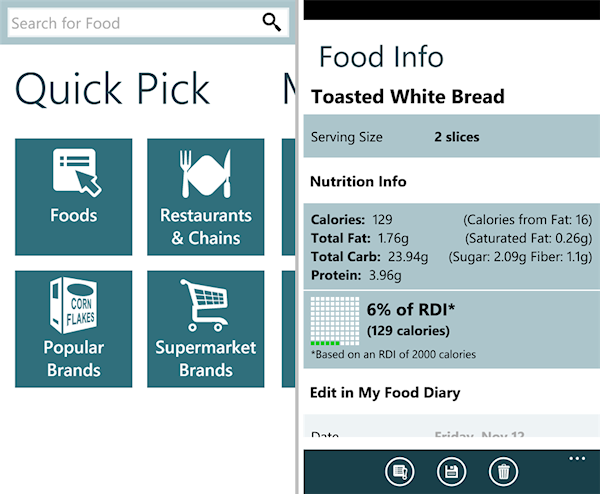
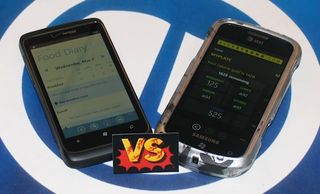
The Windows Phone Marketplace contains a number of apps for counting and tracking calories. The two most popular by far are Calorie Counter by Fat Secret.com and Calorie Tracker, from developer nVentive and LiveStrong.com. Both are currently free on the Marketplace, so which should you choose, dear fitness-conscious reader? Read on to find out.
Calorie Counter (CC)
CC is a smaller scale effort from Fat Secret, so we’ll start with it first. Despite its high ratings, CC has only been updated once so far and lacks Fast App Switching. While the developer may have abandoned it, the app still has a lot to offer for fitness enthusiasts.
Quick Picks
The app’s main claim to fame is the ability to just look up foods and find their nutritional info. To do this, you swipe left or right to the Quick Picks page and choose from four categories: Foods, Restaurants & Chains, Popular Brands, and Supermarket Brands. Each one contains a number of subcategories – as you narrow your selection down, you’re eventually presented with a list, such as different kinds of eggs. You can also just type the name of a product into the search box. Once you find the item you’d like, you can view a selection of nutritional information and its actual USDA nutritional label.
While the range of categories is impressive, the search engine could use some work. A proper search engine would find ‘Cap’n Crunch’ when the user enters ‘Captain Crunch,’ but not this app. Still, if you can’t find the food item you’re looking for, you can manually add it to the category of your choice. You’ll need to know the serving size, calories, types of fat, vitamins, etc. that you’d see on a nutritional label – a reasonable requirement.
Diaries
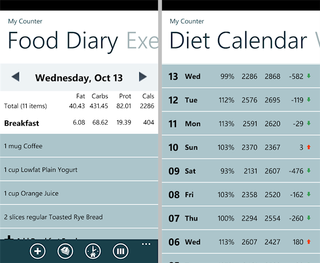
The other benefit from apps like these is the ability to track your daily calorie consumption and burn. In the Food Diary, you’ll enter what you eat for meals and snacks every day. You add these items by searching for the name or selecting them from categories, much like when searching for nutritional info. Users can also save meals to make the process of adding them to the diary go quicker. As items are added to the day’s diary, calorie consumption will be shown as a percentage of RDI (Recommended Daily Intake) in a little chart at the bottom of the page.
Get the Windows Central Newsletter
All the latest news, reviews, and guides for Windows and Xbox diehards.
The exercise diary works in a similar manner. You add an exercise, select from a list of activities such as walking and running, and how long you engaged in the activity. Users can also select ‘Other’ and add stuff that isn’t listed.
The layouts of both the Food and Exercise Diaries are somewhat messy and confusing. The Food Diary requires a lot of vertical scrolling when a more concise layout would be more useful. The RDI graph at the end is fairly worthless too. As for the Exercise Diary, it lists resting and sleeping times and calories above whatever exercises you enter. I would think the more important info (the exercises) would come first, and the other stuff feels more like a nag: “Rest less! You can sleep when you’re dead!”
Long term tracking
CC’s Diet Calendar lists your RDI, Food (calories consumed), Exercise (calories burned), and Net calories for each day of the month. It’s good to look back at these things and judge your performance, but the list is labeled kind of oddly. Also, the RDI figures are based on a 2,000 calorie diet, whereas someone on a diet probably has a different number in mind – it’d be better if the app asked for your goal or helped you create one and then adjusted its charts and such accordingly. Finally, the Weight Tracker graph allows you to input your weight at any given time and chart how it’s changed since you started. The graph includes one line for actual weight and another for your goal weight; use CC long enough and hopefully these will intersect.
Finally, the app can sync with FatSecret.com, a plain looking site that boasts a fair amount of content. Still, I prefer the website associated with our next app...
Calorie Tracker (CT)
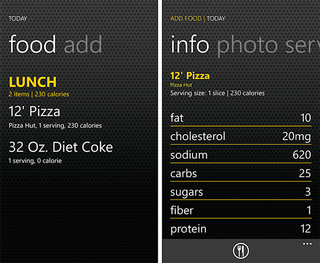
CT is the companion app for LiveStrong.com, a major health and fitness website. As such, it allows users to create and/or connect their profiles with the site, sharing goals and progress between both mediums. The more encouragement to stay on target the better, so the connectivity is definitely appreciated. But even if you choose not to create an online account, you can still get a lot of mileage out of CT.
The first step in using the app is to create a profile. Here you’ll enter some basic stuff like height and weight. You also choose a goal, which can include maintaining your weight or gaining or losing up to 2 pounds a week. Even if you set the weight unit to Kilograms, it still expresses the goal in pounds, which could be a slight knock against CT for international users. The app also asks for your activity level, with choices ranging from Sedentary to Very Active. Using all of this information, it calculates your daily calorie goal, a feature sorely lacking in CC.
MyPlate
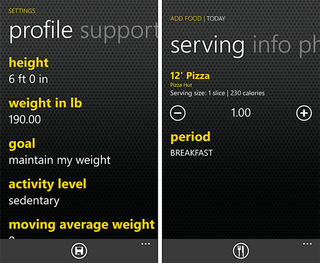
This page is the equivalent of CC’s Food and Exercise Diaries in one. CT presents the information in a super clean way with no need for vertical scrolling, a major plus in CT’s favor. Tapping on a meal or the Fitness category (exercise activities) brings up a list of everything you’ve added for the day and lets you input new items. Instead of browsing for foods or exercises, you just type the name in a search box. The food search engine is much better than CC’s – ‘Captain Crunch’ brought up useful results, despite my spelling it in an unofficial way.
The Fitness search engine is similarly robust. Unlike CC, Tracker actually lists several types of sex as exercises: light, moderate, and vigorous. Considering that sex is an integral activity in many people’s lives, I applaud its inclusion. You can also add custom activities if necessary.
On the downside, you can’t add foods or activities as favorites, so you’ll need to type them out every time. You can’t search for food’s nutritional info without first choosing a meal and searching for the item, so that part of the process is slower than with Counter.
Progress
The My Daily Progress page shows a bar graph with your calorie goal and number of calories remaining at the top. It also lists calories consumed, subtracts calories burned, and your net calories – very clean and simple. The My Weight Progress page charts your weight on a line graph – no target weight, which was kind of unnecessary in CC’s equivalent graph. Finally, the My Goal Page lists your initial weight, actual weight, weight goal, and average weight lost or gained.
Overall Impression
Both Calorie Counter and Calorie Tracker have their pluses and minuses. Tracker is apparently free for a limited time only, but I get the impression it’s been that way for a good while. For now we'll say they're on even pricing ground. Tracker looks much nicer than Counter, and supports Fast App Switching, which Counter does not. Counter’s food finding feature is a step ahead of Tracker, except for the slightly sub-par text search. But as a tool for tracking food consumption and fitness, as well as encouraging users to stay on their fitness plans, Tracker handily outperforms its rival. If you’re interested in losing weight or fitness in general, Calorie Tracker is a must-download.
Calorie Counter Marketplace link
Calorie Tracker Marketplace link
Paul Acevedo is the Games Editor at Windows Central. A lifelong gamer, he has written about videogames for over 15 years and reviewed over 350 games for our site. Follow him on Twitter @PaulRAcevedo. Don’t hate. Appreciate!
